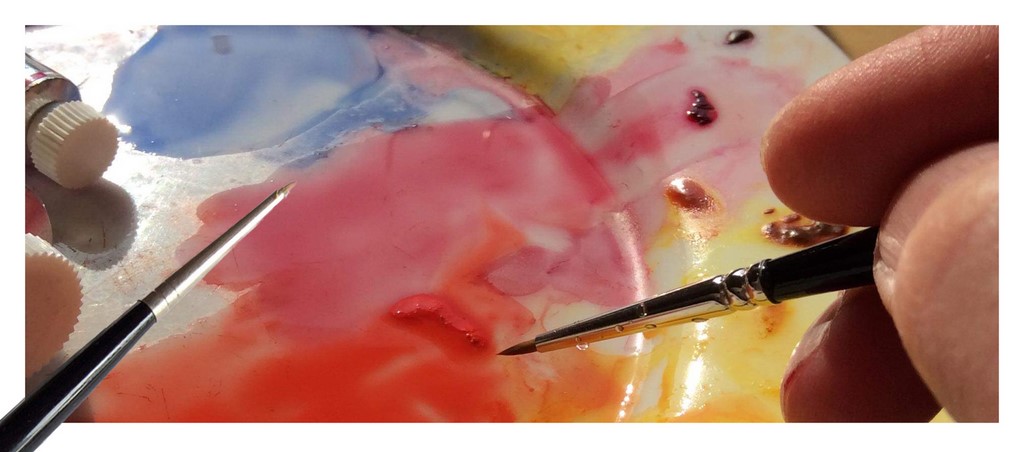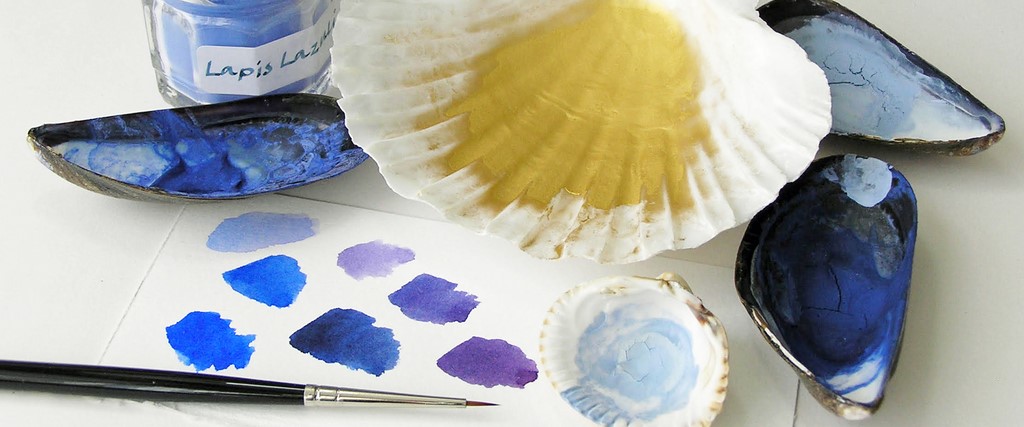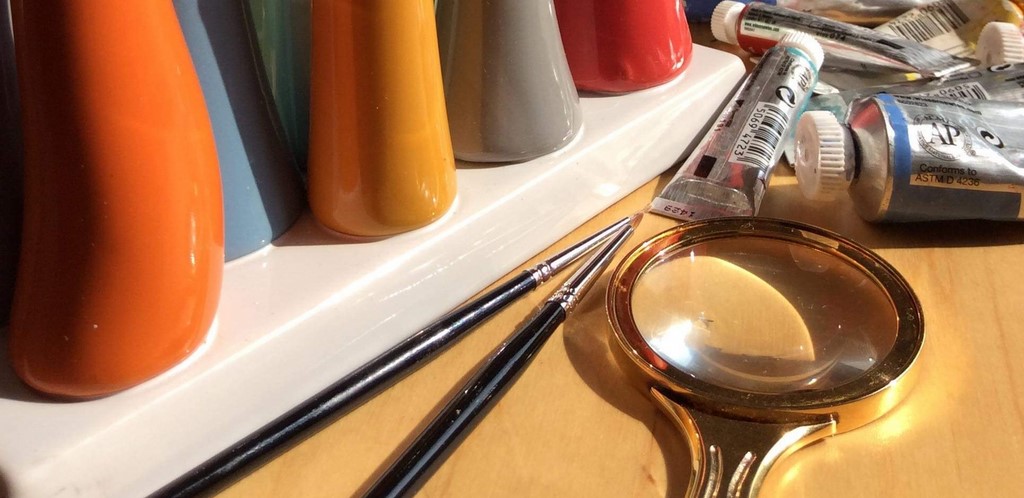What size are miniatures?
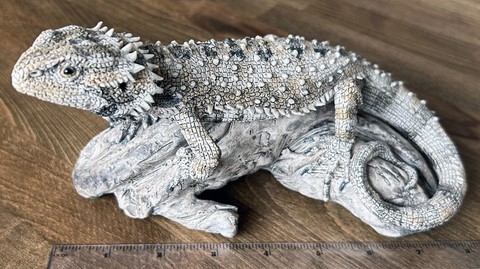
Maximum size limit of framed paintings 6" x 4.5" (15 x 11.5 cm)
and 8" (20cm) for sculpture, across the longest length.
The definition of miniature art is not absolute, but can be explained as artwork within the size remit of 6 x 4.5" and must be of exquisite, fine detail. examples of members miniature work
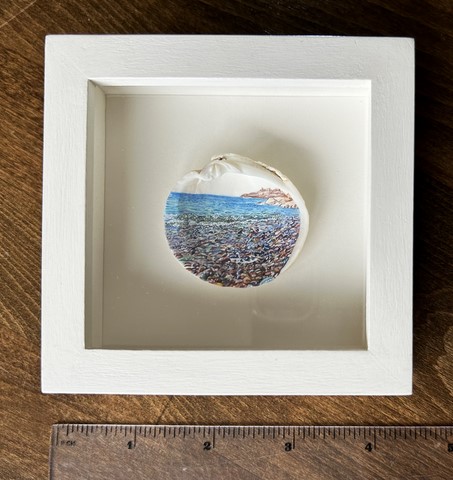
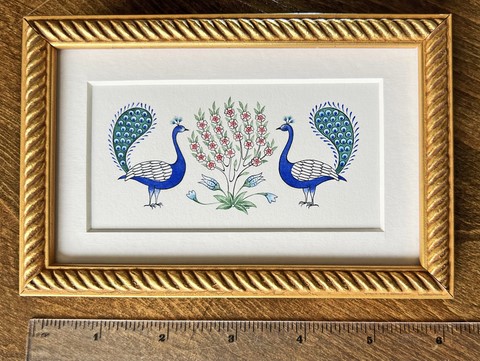
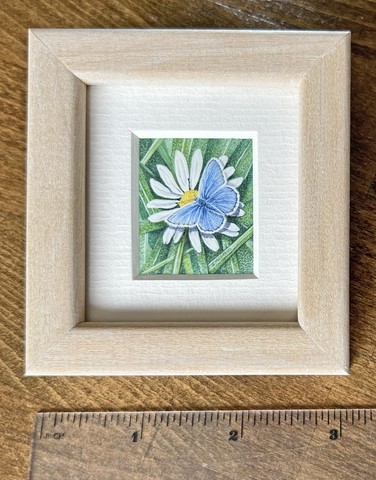
What books are available?
‘The Techniques of Painting Miniatures’ by Sue Burton. This book is out of print but is still available on Amazon. It also deals with all aspects of miniature painting by drawing on the experience of 28 leading miniaturists’.
Are there demonstrations I can attend?
What brushes will I need?
Two of the companies which specialise in miniatures brushes and will post out your requirements are:
Polymers Plus, who have a wide range of materials as well as brushes.
Rosemary and Co have a full range of brushes and orders placed usually arrive within 24-48hours.
Both companies are very helpful and will be happy to advise.
What medium should I use?
Most people who take up the challenge of miniature painting will already have had some experience of painting and will have a selection of paints. However some may take the opportunity to try a different medium.
Acrylics are popular because they are versatile, fast drying, and mistakes can be rectified with relative ease.
Watercolour is the more traditional medium, and the image is generally built up in layers of ‘stippling’, or tiny dots. It is recommended that if you are purchasing watercolours for the first time, to buy artist’s quality, not student range. There is a world of difference between the two.
Oil paint is another option but it appears that acrylic has largely taken its place for ease of use
What paper or surface should I use?
Paper. Hot pressed (HP )paper is smooth - as opposed to NOT which has a rough texture - and Arches is one of the most widely used.
Vellum. This is a specialist surface and unless you are very keen to try everything, it is best left for future experimenting. It is available from Polymers Plus.
Ivorine and polymin. Ivorine was a man-made substitute for ivory which is no longer used, for conservation reasons. However, ivorine is now no longer available in the UK and polymin has taken its place. This can be purchased at Polymers Plus. Because it is a non-absorbent surface, it can be challenging to work on but for portraits particularly, it is a popular choice because it has a quality of light which cannot be achieved on paper.
This surface is fully dealt with in Pauline Denyer-Baker’s book.
Will I need a magnifying glass?
Lighting
Some artists may only work during daylight hours and have maximum daylight in the work room. The reality however is that for most of the winter months, an artificial light source is necessary, and a daylight bulb is by far the best. There is little or no colour bias, and it is much easier on the eyes. Daylight bulbs can be purchased from craft shops, and a good selection of daylight lamps is also available from The Daylight Company.
Expert advice from some of our top miniature artists:
‘I use vellum and Arches paper for my work. I don’t recommend using vellum until you feel comfortable with your standard. It is quite absorbent and it can be difficult to rectify mistakes.’
'I use Arches paper for larger work, but have always painted miniatures on vellum. It is a beautiful, smooth surface with enough " bite" to hold on to the paint and provides a robust ground for layers of watercolour to be built up by stippling, resulting in intense, jewel-like colour. I don't think mistakes are more difficult to correct than on paper. I use Windsor and Newton artists watercolour paints and Windsor and Newton Series 7. Miniature. Finest Sable brushes sizes 0, 00 and 000.'
'I use series 33 kolinsky sable brushes (from Rosemary and co) in sizes from 10/0 up to 1, and most of my watercolours are Winsor & Newton or Daniel Smiths. Be aware that colours may have the same name but each brand is slightly different. I like Arches HP paper (I often prefer to do my initial drawing on a separate sheet of paper and then trace it lightly across to the Arches paper when I’m happy with it, thereby avoiding any erasing on the final surface, which can ruin it for miniature work). I also use a hand held magnifying glass.'
‘ I use any HP watercolour paper and I buy my brushes from a model shop. They are nylon but when the point goes I use them for watercolour washes’
MEDIA:
Oil - Paint made of pigments suspended in an oil-based solution
Pencil/graphite/plumbago - A crystalline form of the element carbon
Watercolour - Paint made of pigments suspended in a water-based solution
Gold Leaf - Solid gold beaten thinly to an almost transparent sheet. In varying shades and carat.
Gum Arabic - Acacia gum from the acacia tree
Shell Gold - Gold leaf powder mixed with gum Arabic (see gum Arabic) to create a viscous medium
Bronze - An alloy consisting primarily of copper, commonly with about 12% tin
Palladium - A rare and lustrous warm silvery-white metal
Porcelain paints - Dry pigments for porcelain painting heated to temperatures between 780°C and 1,250°C
Sterling Silver - Precious white metal (92.5% > pure silver)
Stoneware - Made primarily from stoneware clay, is nonporous and can be glazed or unglazed.
Vitreous Enamel - A material made by fusing powdered glass to a substrate by firing, at 850°C. The powder melts, flows, and then hardens to a smooth, durable vitreous coating.
Wax - A specialist wax usually encaustic wax can be modelled, carved or cast and can be used for a variety of art objects.
SURFACES:
Canvas - Linen fabric usually has gesso to create a smooth surface (see gesso)
Paper - Arches, Hahnemuhle, Canson, Schoellershammer
Vellum - Prepared animal skin or "membrane" used as a material for writing or painting on.
Dura-Lar - A polyester film combining Mylar® and Acetate. A highly versatile smooth film that will not tear, absorb moisture or discolour.
Ivorine - A celluloid product resembling ivory; white, smooth.
Polymin - A semi-transparent non-absorbent polymer similar to Dura-Lar and ivorine.
Gesso - From the Latin: gypsum. A white paint mixture consisting of a binder mixed with chalk, gypsum, pigment, or any combination of these. It is used in artwork as a base for paint and other materials that are applied over it.
Porcelain - A ceramic material made by heating materials, generally including kaolin, in a kiln to temperatures between 1,200 and 1,400 °C
Wood - Mahogany, pear, cherry, apple, box – all types of wood with an inherently tight grain and smooth surface
TECHNIQUES:
Engraving - The process of creating a design by using a burin or cutting tool to cut into a metal plate, often copper.
Onglaze porcelain painting - Decoration of glazed porcelain. Firing temperature 780 - 820°C
Underglaze porcelain painting - A method of decorating in which painted decoration is applied to the surface before it is covered with a transparent ceramic glaze and fired in a kiln with 1250°C.
Silver Point - Made by dragging a silver rod or wire across a surface, often prepared with gesso
Verre Églomisé - A French term referring to the application of gold leaf onto glass. A design is applied by various techniques, often reverse painting prior to gilding or by scoring the design into the gilded layer with the background applied last.

